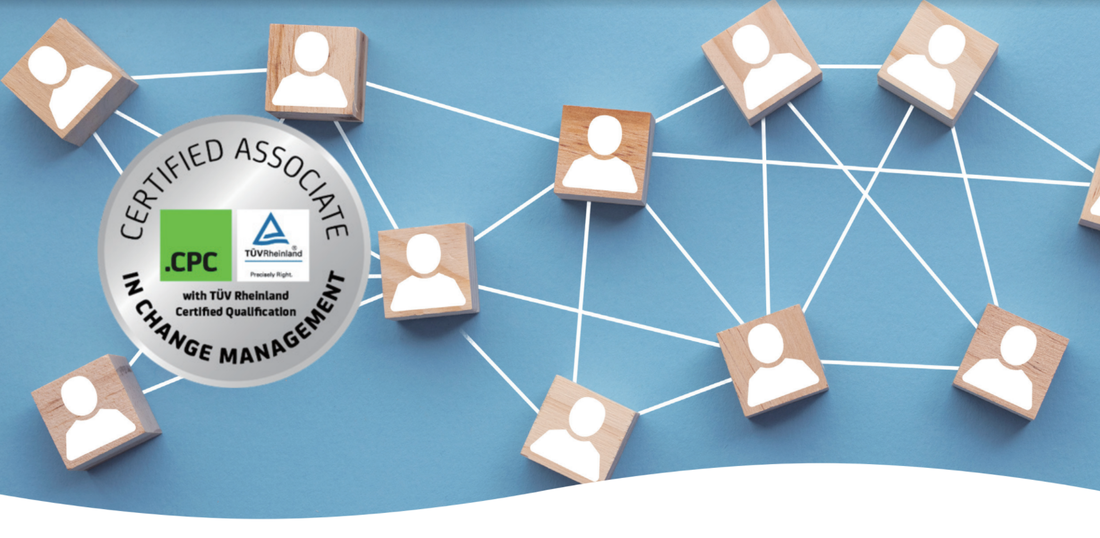|
Hive17 Consulting is excited to announce the partnership between CPC Consulting and TUV Rheinland to bring a new change management certification to Singapore and Southeast Asia. These two partners have been offering the programs in Germany and China and now decided to expand their regional reach.
Change is a constant in today's times - we are all on journeys to capture new markets and innovating our value proposition to our customers. How successful are your transformation initiatives? Do you have the feeling that the adoption takes too much time? What is your recipe against low motivation and high resistance? The certification program designed by CPC Consulting is successfully combining a broad view across different methodologies and distilling these into their own clearly structured and hands-on approach. Hive17 Consulting is endorsing the CPC methodology not only based on its simplicity; we also support the hybrid learning path: the program is structured in three tiers, as a combination of asynchronous online learning and synchronous classroom workshops. What do you think about these programs? Who in your organisation network might be interested as well? Please spread out the exciting news to interested friends.
0 Comments
A few weeks back, I shared some views how you can let go of control. Why would you want to do that? Because the people at the front know how to create value to our customers; and they need to be able act fast without barriers - control from the top. Have a look at the previous post: Letting Go of Control - Made Easy?
Once you let yourself guide by others, how do you get up along the U? That's a valid question I received after sharing the last post. Here are some thoughts around the right side of the U. Before we climb up, let me share more about the left side and the valley. With the steps on the left side, you can imagine that you are going down a hill. In the moment you think that you let yourself be guided by others, you realise that hill turns into a cliff and you need to climb further down. And most probably it feels like you are walking in a fog; there is no view of the other side of the valley. It feels like going through a tunnel or crossing the sea. I like this analogy because in problem solving you often want to immerse yourself in the current situation like an anthropologist and thoughts around possible solutions should be far away - early solution ideas might only lead you into a wrong direction. Only when you really let go and you are in that opaque place, the magic can happen. Ok, not real magic, though it might feel like this. When we are drifting (not consciously seeking anything) then suddenly things will get clear, the new journey will appear right there. This might sound very esoteric but it is not. People who practice design thinking might be able to share similar experiences when they get inspired by empathising with the people they are creating value for. Long prologue... So now, how does that journey up the hill look like?
Reflecting on the entire journey along the (theory) U, I think the right side might be more familiar. The big part of letting go of control happens on the left. Letting go of judgment, ego and power are essential for this new leadership. It starts with difficulties on the path down (left), and it continuous inspired on the path up (right). It does feel like a freedom once we don't need to control anymore. How did you apply these steps into your leadership role? End of last year, in the context of an agile transformation in a global financial institution, we delivered a series of design thinking trainings to a global audience. The sessions introduced the people-centric problem solving methodology, shared some case studies, and allowed the participants to practice some of the tools. After the program, we checked in with the teams and observed that they didn't take up design thinking in their practice.
How often did you observe that your training efforts have little impact on people's daily work? What can we add to bring the excitement from the training back to work? In my experience, this is an essential step for success. At the bank, we selected a few teams that were excited about design thinking and willing to explore ways how they can overcome barriers and adopt the new principles and tools in their daily work. Typical barriers were a strong focus on delivery, very limited perceived time for other activities, a feeling that there was not much room for creativity. On top of this, the team also needed to build confidence with the methodology itself. So, the journey began. Two important things we laid down from the start: everyone in the team is committed; what we are doing is relevant for daily work. We reviewed the deliverables for the quarter and based on that, the team identified areas where the team required a better understanding what the customers needed. Based on this, we started an iterative process to identify the best ways bring design thinking into people's daily work. Here are some of the lessons learnt:
One way we reduced the number of tools was the way we looked at the journey map. This became the key canvas to collect information during the inspiration phase. The map included the personas, the process steps, the needs and tools required, and the insights via a mood curve. These journey maps started with a broad scope and later we narrowed them down to a small scope which reflected the current activities. We used them first to collect information from within the extended team and then showed them to groups of customers (internal stakeholders) to validate assumptions and gain further insights. While it took time to find a good way to bring design thinking methods into people's daily work, the team appreciated that we have cultivated a customer-centric mindset and provided a path to regularly interact with the customers. This allowed the teams to build deliverables that are much closer to the need of the customers and create more value. Now the initial efforts are shared to other teams and the seed is passed along. What is your experience to cultivate customer-centricity in your teams? Image source: Ideo U. Back when I was working in Europe, I had my tradition to be in the office over Christmas. Undistracted and focussed working time - that is what I was seeking. And I experienced in these weeks that I was able to complete a lot more work in the 5-6 hours at my desk. And here I am reading the scientific evidence of that:
“Research indicates that five hours is about the maximum that most of us can concentrate hard on something,” says Alex Pang, founder of Silicon Valley consultancy Strategy and Rest. Some companies have tried to reduce their working time down to 5 or 6 hours a day and saw productivity improvements. And the employees enjoyed the additional free time. A perfect balance. And yes, when we focus on work and remove distractions, we able to find a flow that allows us to get more done in less time. My experience is confirming this; when I am blocking 2 hours for a specific task, I am able to create a lot more results than if I am forced to split that into several 30 minutes slots. Though, it is not all sunshine with the 5-hour workday idea. The increase in productivity will not lead to additional output overall. The new productivity level will not translate into an 8-hour workday. Some managers might wish so. Companies also observed that the stress levels increased. Employees felt pressured to squeeze everything they have done in eight hours before in their new five hour period. This is not always easy and creates tension. And, in the long run companies observed that connections between the employees and relationships started to deteriorate. There is no time for a joint coffee or lunch break. That's how I felt in my empty office during the Christmas break: great to get things done; though, now I need to discuss my ideas with my peers and get inspired by them. This leads to another element that is essential for lasting success in a complex ecosystem: randomness. We need time to ponder and tinker; these watercooler conversations often spark new ideas. Idle time is one key ingredient to creativity. That is how we are solving problems. One final question: do we need to tell people how long and when they are working? I prefer to give people freedom and autonomy to choose their time for work. Instead, let's focus on the achievements which we aspire in our group:
It is great to know that our productive time is limited to five hours a day. Let's use this fact to reduce the pressure from people. Let them choose their preferred ideal working time. And let's start to focus on what really matters. How will you use these ideas in your team? Source: The perfect number of hours to work every day? Five, WIRED, June 2021 |
Subscribe
Receive our monthly themed summaries of our thoughts: click! TimTim is a change practitioner in the area of innovation and excellence. He is working with teams to accelerate innovation, collaboration and agility. Categories
All
Archives
July 2024
|





 RSS Feed
RSS Feed